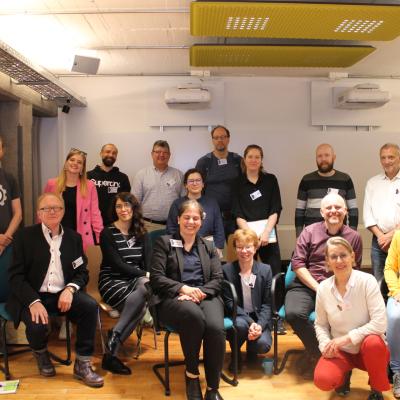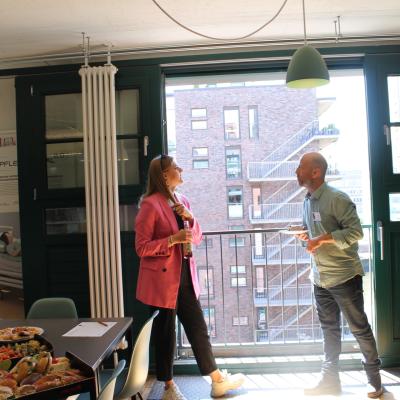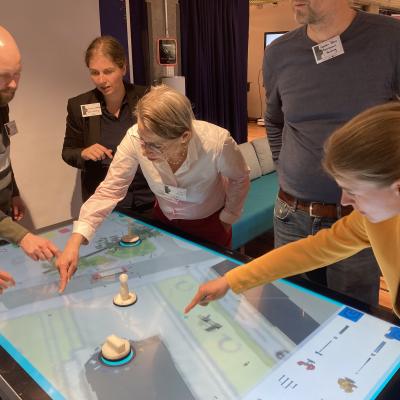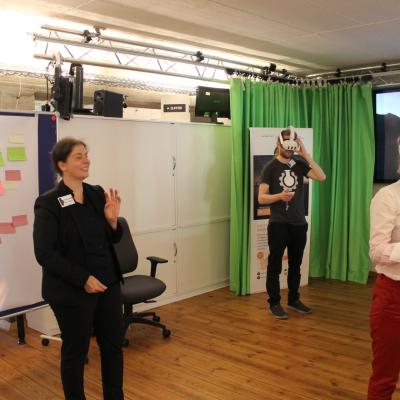The workshop series "Sustainable Lighting Strategies for Altona" provides a platform for regional stakeholders and interest groups to engage in joint planning processes. The kick-off workshop on the 30th of May 2024 included information sessions and interactive phases, focusing on sustainable lighting strategies for demonstration sites in Altona using XR (Extended Reality) planning tools.
Hosted by the Hamburg DARKER SKY project team from Hamburg University of Applied Sciences (HAW Hamburg) and the Hamburg-Altona district office at the Research and Transfer Center Digital Reality (FTZ).
Various stakeholders were invited to join the workshop, they included representatives from the Hamburg Traffic Facilities Ltd. (HHVA), Authority for Environment, Climate, Energy and Agriculture (BUKEA), Metropolregion Hamburg, State Agency for Roads, Bridges and Waterways (LSBG) and the Hamburg-Harburg district office.
The DARKER SKY project team introduced the workshop, discussing the increasing problem of light pollution in urban and rural areas. They highlighted the project’s aim of promoting interdisciplinary exchange and building dialogues between authorities and the role of the two demonstrator sites in Hamburg.
The role of light at the Hamburg demonstrator sites
Photo: Anna Vollmer
Lighting is particularly significant in the context of pedestrian and bicycle traffic. The Altona district and city of Hamburg have responsibilities at various levels to ensure that traffic routes are safe. It is essential to consider the perceived safety of citizens. Important daily traffic routes, such as the way to work or school, are frequently discussed in this context. The need for lighting contrasts with its negative environmental impacts. The districts and authorities in Hamburg are tasked with balancing these interests in future planning.
Two demonstration sites were selected in the Altona district of the city of Hamburg to test new solutions considering all stakeholders:
- The Elbuferweg is one of Hamburg's most popular and frequented routes. It serves as both a recreational area and a central traffic route for many cyclists heading to the city centre. Its proximity to the Elbe River creates a conflict between lighting needs and environmental protection.
- The Sülldorfer Knick/Bullnwisch focuses on a section with high everyday use.
The work at these demonstration sites aims to derive recommendations for municipal practice to be used for DARKER SKY.
Discussion highlights: Balancing lighting needs and environmental concerns
Participants engaged in a discussion with the DARKER SKY team about balancing the need for adequate lighting with environmental concerns, public safety and individual perceptions:
Main sources of light pollution:
Major contributors include increased vertical light emission from LEDs, outdated street lighting systems, light reflection from bright surfaces, architectural and advertising lighting and unregulated private lighting.
Lighting quality vs. brightness:
Effective lighting does not require maximum brightness. Good lighting requires a good lighting concept. Proper contrast management and reducing glare can improve light quality and safety without increasing brightness, aligning with the goal of reducing light pollution.
Age-related lighting needs:
Current lighting standards are based on average visual performance and do not account for the different needs of younger or older individuals.
Effectiveness of lighting standards:
Historical evidence from Hamburg’s 50% reduction in street lighting during the oil crisis showed no significant impact on accident rates but reduced light pollution.
Ownership of urban light:
The discussion highlighted that private lighting significantly contributes to light pollution, with households illuminating their properties without regulations, leading to frequent complaints to city authorities.
Perspectives of environmental lighting with XR
Photo: Anna Vollmer
During the planning sessions the XR (Extended Reality) planning tools (VR, touch-table), currently being developed by HAW Hamburg, were presented, along with an introduction to their use. Two groups used the planning tools to outline scenarios for more environmentally friendly lighting in one of the pilot areas in Altona and gathered ideas for further development of the planning tools.
The touch-table
The participants gathered around the touch-table, where they could adapt the lighting in a 3D model of a section of the demonstrator site. They tested different lighting scenarios, such as varying lamp posts, brightness, colour, angle, shielding and height. The changes made on the touch table and their effects on the surroundings were displayed on a big screen for everyone to see.
Photo: Anna Vollmer
The VR glasses
These adjustments were also visible in the 3D model viewed through VR glasses used by another group. Like on the touch table, participants could modify the lighting and test different scenarios. Three VR glasses were available for testing, while others could observe the VR experience on a separate screen. Both tools allowed participants to see how lighting changes affected the surroundings, including elements like a person or bike placed in the 3D model. This enabled comparisons between old and new lighting strategies.
The XR planning tools are bridging a crucial gap in urban planning and sustainability efforts. Traditional planning methods often struggle to effectively visualise and communicate the complex interactions of lighting solutions in real-world environments. These XR tools allow stakeholders to virtually experience and adjust lighting scenarios in 3D. This immersive capability enables them to see firsthand how different lighting configurations affect urban landscapes, from pedestrian safety to environmental impact. By filling this gap, the XR tools empower planners, authorities and community members to collaboratively design and implement more efficient and sustainable lighting solutions for urban spaces.
Collaborative efforts and future steps for sustainable lighting in Hamburg
Photo: Anna Vollmer
In the concluding round, participants discussed the need for greater flexibility and willingness among stakeholders, along with perspectives on further steps.
A central theme was the exchange and networking of relevant stakeholders in Hamburg. They debated who should be involved to develop holistic and practical lighting strategies. The importance of various perspectives from offices, authorities, political decision-makers and city institutions was emphasised. Despite strong interest, there has been no initiative to bring stakeholders together. Establishing a platform for exchange was seen as desirable. As well as, implementing regular awareness campaigns for institutions and the public and creating contact points for lighting information and reporting disruptive light sources. A long-term goal for Hamburg could be a unified, sustainable and cross-sectoral lighting concept.
Key discussion points included:
- Strengthening authority involvement:
- Central coordination and clear role definitions within agencies.
- Adjusting regulatory guidelines or planning policies as needed.
- Developing a comprehensive, cross-sectoral lighting concept for all types of lighting (streets, buildings, advertising).
- Establishing citywide light monitoring and regular stakeholder meetings.
2. Involving additional stakeholders:
- Police, Chamber of Architects, district urban planning departments, crime prevention units, schools (to engage parents through students), the Chamber of Commerce, social safety organisations, conservation groups and political parties.
3. Ideas for Altona demonstrator sites:
- Testing motion sensors.
- Organising walks with various interests and age groups to assess lighting
The workshop highlighted the critical need for balancing adequate lighting with environmental concerns, public safety and individual perceptions. It fostered interdisciplinary dialogue among stakeholders, showcased the innovative XR planning tools and emphasised the importance of collaborative efforts to develop holistic and practical lighting solutions.





